.jpg)
"This film shows the horror of war to the next generation"…Lt. Jim Lawrence, XO, Delta Co., 2-7 Cav.
During the long, hot walk to Landing Zone Albany in the Ia Drang Valley, Specialist 4 Bob Towles of Delta Company, 2nd Battalion, 7th Cavalry’s Anti-Tank Platoon, in about the middle of a 550-yard-long column of more than 350 men, gets word that it’s time to take a break. Sweating in the hot sun, he drops his three LAW rockets and reaches for some water. One of the men alongside him points into the jungle and asks, “Are those our flankers out there?” Towles glances over. “I think so,” he replies.
Suddenly, the men hear a shot ring out from the head of the column, then several more, followed by automatic weapons fire and mortar rounds. The company is ordered to form up and wait. The troops peer into the jungle toward the gunfire and watch for the flankers to retreat back to them, but they never do. Instead, seconds later, enemy fire pours through the bush—zeroed in on them and so thick it seems like a swarm of bees—followed by North Vietnamese Army (NVA) soldiers running through the jungle right into them. Knocked off his feet by an exploding rocket propelled grenade (RPG), a stunned and bleeding Towles gets up, fires his M-16 rifle at the onrushing enemy. He fires at another, then another. But Delta is being flanked and overrun on all sides.
“Cut!” I shout. “Great shot. Excellent job.” The real Bob Towles, standing beside me, nods in agreement.
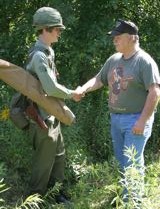 The actor “Bob Towles” was one of my Lorain County Joint Vocational School (LCJVS) students, Matt Schmidt. He and others in my high school American Military History class were in northern Ohio in the spring of 2009, portraying a day of the Vietnam War that had long fascinated me—the rest of the story in the film We Were Soldiers about the cavalry troopers who stayed on after the fight at LZ X-Ray. In the book We Were Soldiers Once…and Young, on which the movie was based, authors Lt. Gen. Harold Moore and Joseph Galloway gave a full accounting of the battle that followed X-Ray—Albany. I had decided to re-create some of the scenes from the book for my own documentary, A Walk in the Sun, and to make it part of my students’ learning experience. As a reenactor, I had always wanted to involve my students in living history. When one student suggested that we film scenes of the history they were learning, so began a series of films my classes have worked on, ranging from the Colonial Rogers’ Rangers to the Marines on Iwo Jima.
The actor “Bob Towles” was one of my Lorain County Joint Vocational School (LCJVS) students, Matt Schmidt. He and others in my high school American Military History class were in northern Ohio in the spring of 2009, portraying a day of the Vietnam War that had long fascinated me—the rest of the story in the film We Were Soldiers about the cavalry troopers who stayed on after the fight at LZ X-Ray. In the book We Were Soldiers Once…and Young, on which the movie was based, authors Lt. Gen. Harold Moore and Joseph Galloway gave a full accounting of the battle that followed X-Ray—Albany. I had decided to re-create some of the scenes from the book for my own documentary, A Walk in the Sun, and to make it part of my students’ learning experience. As a reenactor, I had always wanted to involve my students in living history. When one student suggested that we film scenes of the history they were learning, so began a series of films my classes have worked on, ranging from the Colonial Rogers’ Rangers to the Marines on Iwo Jima.
A Walk in the Sun tells the story of 2nd Battalion, 7th Cavalry Regiment, 1st Cavalry Division (Airmobile) and two companies of the 1st Battalion, 5th Cavalry at LZ Albany during the final two days of heavy fighting in the Ia Drang Valley. Outnumbered by the enemy and cut off from reinforcements on Nov. 17, 1965, the exhausted soldiers wondered if they would make it out alive. About 350 U.S. soldiers marched into the fight, where they faced an estimated 1,500 to 2,000 NVA. Of those 350 Americans, 155 died in the battle.
To tell this story accurately, we had to make contact with the men who fought there. I was acquainted with war reporter Joe Galloway and he put me in touch with Captain George Forrest, commanding officer, Alpha Company, 1-5 Cav; 1st Lt. Larry Gwin, executive officer, Alpha Company, 2-7 Cav; and Towles of Delta Company, 2-7 Cav, who had written his doctoral thesis on the battle. They were to be the main characters portrayed in the movie, but when word got out about the project, more than 20 veterans of the battle wanted to be interviewed.
Larry Gwin sent me pictures of the Ia Drang Valley and, surprisingly, it was a pretty close match to terrain in northern Ohio, where my parents had several acres of property we could use for location filming. My consulting vets said it would work for the Central Highlands.
From the interviews, I drafted the screenplay, which included dialogue, narration and camera shots for all the scenes. I had the veterans edit it and made their corrections. To set the stage for the battle, each soldier’s storyline had to be introduced as well as their unit and fellow troopers. The screenplay provided the basis for our filming schedule, which ran spring through fall 2008 and spring through fall 2009 and included days for close-up shots and days for long, landscape scenes. Bob Towles, who lived nearby, was with us every day of filming except one. Specialist 4 Dick Ackerman, of Recon Platoon, Delta 2-7, was able to attend one day of filming as well. The movie was shot on mini-digital videotape and featured an original sound track written and
performed by Oberlin College Conservatory students.
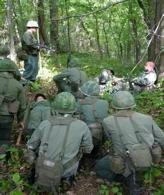 One of the most valuable aspects of this kind of interdisciplinary teaching approach is its ability to create energy and enthusiasm for learning history. It’s not just about relating facts; it’s about remembering stories of courage and sacrifice. Students not initially involved became curious and wanted to learn more about the Vietnam battle; in all, more than 100 students participated from classes as diverse as history, carpentry, electricity and cosmetology. We also had input and support from our community. Newspaper, radio and television interviews during filming told the story of how LCJVS students were re-creating the fight at LZ Albany. The movie was shown on local cable television throughout the county.
One of the most valuable aspects of this kind of interdisciplinary teaching approach is its ability to create energy and enthusiasm for learning history. It’s not just about relating facts; it’s about remembering stories of courage and sacrifice. Students not initially involved became curious and wanted to learn more about the Vietnam battle; in all, more than 100 students participated from classes as diverse as history, carpentry, electricity and cosmetology. We also had input and support from our community. Newspaper, radio and television interviews during filming told the story of how LCJVS students were re-creating the fight at LZ Albany. The movie was shown on local cable television throughout the county.
As A Walk in the Sun opens, 2nd Platoon of Alpha Company, 7th Cavalry, under Lieutenant Gordon Grove, leaves the LZ X-Ray perimeter on the morning of November 17, bound for LZ Albany after three sleepless nights of missions and patrols in the area. Tension grows among the troops as they wonder what happened to the numerous dead NVA soldiers they had seen the previous day while scouting the same area. If the dead men had been picked up by their comrades during the night, could the North Vietnamese still be in the valley, waiting somewhere ahead of them in the jungle?
With his platoon halted, Sergeant John Eade realizes that the typical air cover of gunships is no longer overhead. Uneasy about that, he asks his squad leader, Staff Sgt. Megdelio Caraballo-Garcia, “Where are the gunships that are supposed to be covering us?” Caraballo-Garcia says, “I don’t know, maybe they’re keeping out of sight so they don’t give our position away.”
Tense marching music plays as the column is halted in the open, in tall grass surrounded by jungle. Recon Platoon’s 2nd Lt. Pat Payne and Staff Sgt. Ron Benton have captured two NVA soldiers.
With the battalion halted, its commander, Lt. Col. Robert McDade, moves to the head of the column to personally interrogate the prisoners and then calls all of his company commanders to come forward at once. As he and his command group move to an island of trees in the center of the Albany clearing, the film’s narrator announces, “The stage has been set for one of the bloodiest battles of the Vietnam War.”
McDade briefs his company commanders, and Delta’s Recon Platoon moves across a clearing on the other side of the island of trees when the first shots ring out. Payne, Benton and Ackerman hit the ground in a hail of bullets. Ackerman and three others dart to the tree line.
Payne rushes back to the command post in the copse of trees and requests to pull his platoon back across the clearing and set up positions in the trees for a better field of fire. Given the OK, he hurries to Recon Platoon, finds his radioman and yells into the radio: “All recon squads, this is Recon 6! Listen up! On the count of 3, move back across the LZ to the tree line…. All recon, here we go, 1, 2, 3, go, go go!”
To give my students a sense of the chaos and cacophony of battle, our Interactive Media teacher, Rob Crossley, hauled a sound system into the field. We couldn’t re-create the bullets whizzing by their heads, but I wanted to envelope the actors with the sound of combat.
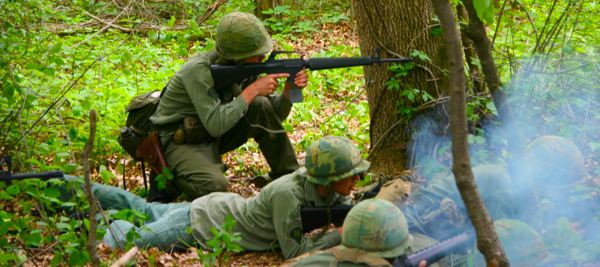
Crossley’s class created animated maps that show the soldiers’ positions and troop movement, so viewers could make sense of the unfolding battle. We also spliced in actual U.S. Army combat footage for its historic impact. I wanted more special effects than our previous films had, so Crossley’s students devised explosions, muzzle flashes, bullet strikes, an RPG launch and helicopters in flight, most added scene by scene during post-production.
For one night shot, filmed in daytime, we simulated the flight and landing of a helo at 2230 hours on November 17, when the cavalry came to the rescue under heavy fire. That night, flight leader Major Will Bennett led 12 helicopters of Alpha, Bravo and Charlie companies of the 229th Helicopter Assault Battalion to evacuate the wounded and bring Bravo Company, 2nd Battalion, 7th Cavalry reinforcements.
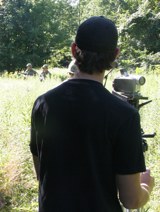 We filmed the sequences using a Vietnam-era Huey at an American Legion post in Holmesville. For the interior shots of Bravo Company Chief Warrant Officer Lee Komich’s night flight into Albany, we covered the helo’s windows with blankets and in post-production added special effects to re-create tracers and the aircraft’s movement. With “whup whup” sound effects, the helicopter appears to be flying as it approaches the landing zone.
We filmed the sequences using a Vietnam-era Huey at an American Legion post in Holmesville. For the interior shots of Bravo Company Chief Warrant Officer Lee Komich’s night flight into Albany, we covered the helo’s windows with blankets and in post-production added special effects to re-create tracers and the aircraft’s movement. With “whup whup” sound effects, the helicopter appears to be flying as it approaches the landing zone.
“Look for red light over LZ,” Captain Ken Weitzel, the 229th’s liaison on the ground, radios to Bennett’s helos. Guided in by the flashlight’s beacon, Komich lands the chopper while the narrator describes the scene:
“Komich’s crew chief, Spc. 5 Richard ‘Smitty’ Smith, watching out the door as the helicopter came closer to the ground, was guiding Komich to a safe touchdown when he saw a stump sticking out of the grass that they were about to land on. Smitty yelled in the intercom, ‘Go forward, go forward!’ Komich did exactly as he had trained and put the Huey down. Immediately there were men running up to the helo with wounded while the crew began dumping ammo, medical and ration crates out the other side. Five to eight men were loaded on board and then the chopper lifted off.”
Animation shows the waves of helicopters that landed in groups of two throughout the night under heavy fire, with only one pilot being hit. In the action sequence, troops jump off under fire while tracers, smoke and chaos surround them.
Leading one of the platoons, 2nd Lt. Rick Rescorla yells, “Come on, let’s let them have it!” when he and others jump from the helicopter and run to the U.S. lines, as men in the trees cheer. Lieutenant Gwin would remember years later that this was the most heroic and boldest air assault he’d ever witnessed.
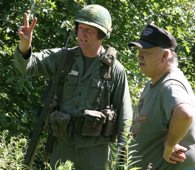 The film is not sugar coated. I wanted my students to understand what it means to be a soldier, and the book We Were Soldiers Once…and Young conveys that. Weeks in advance of filming, students learned about the battle through lectures, films and veterans’ recollections. Joining the student cast were some school staff, reenactors and military recruiters.
The film is not sugar coated. I wanted my students to understand what it means to be a soldier, and the book We Were Soldiers Once…and Young conveys that. Weeks in advance of filming, students learned about the battle through lectures, films and veterans’ recollections. Joining the student cast were some school staff, reenactors and military recruiters.
The temperatures during shooting reached into the 90s, about 15 degrees cooler than the Ia Drang battle, but still hot for those not used to it. We had period items to give us the look of an actual 1965 Cavalry unit in the Central Highlands. Army Navy stores and the Internet were my “quartermaster depots” for authentic uniforms and equipment, with funding help from the local VFW, American Legion and AMVET posts. Reenactors and collectors donated items for props to help with authenticity as well. We used the OG-107 cotton twill uniform issued at the beginning of the war, not the jungle fatigues that were just coming out, along with all-leather black boots and the 1956 webgear, not the 1967 nylon. We did the best we could with period haircuts and makeup, provided by some of the school’s cosmetology students.
Actors were issued their uniforms, helmets, load-bearing equipment and M-16 rifles (airsoft), as well as their food for the day—canned “C rations” donated by a local grocer. They carried water for the day in two plastic canteens—the only items the actors were required to purchase from a local Army Navy store. Students acting as squad leaders had to make sure their canteens were filled. Some were detailed with extra duty such as keeping track of an 81mm mortar and a PRC 25 radio and other items built as props.
I made dog tags for all of the students that included their parents’ phone numbers, just in case. They carried individual first-aid kits in painted Altoid tins, and were to take care of themselves as best they could in the field. One adult served as a “medic” to see that no one was dehydrating or having any other problems. The two veterans of the battle on location gave actors encouragement and advice, showed them how to carry a pack or rifle, and gave them firsthand descriptions of how the action unfolded. Students learned what it means to be tired, hot and thirsty while carrying a heavy pack, and about the loyalty soldiers have for each other and the sacrifices they make.
I had explained to students that we were re-creating a traumatic event in real people’s lives and we needed to do it with the utmost respect and authenticity possible. Everyone behaved admirably, and, I believe, gained important insights. As one of my students told me: “When I’m now tempted to think how miserable the summer heat can be, I remember that it’s not 105 degrees, I’m not thousands of miles from home, I’m not carrying 60 pounds of gear and no one is trying to kill me. These guys went through a lot, and many still are. The brief experience of doing this film made me more aware of our soldier’s trials.”
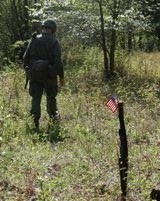 In the movie’s final scene, soldiers killed in action lie on the ground while men are cleaning up the landing zone. There’s a lone U.S. flag on an anthill, and a soldier picks it up. He walks to where the bodies are lined up for evacuation and sticks his bayoneted M-16 into the ground. He wraps a rubber band around the gun’s butt and places the flag there, while the camera pans from it to the row of KIA, most covered in ponchos. The film’s narrator intones:
In the movie’s final scene, soldiers killed in action lie on the ground while men are cleaning up the landing zone. There’s a lone U.S. flag on an anthill, and a soldier picks it up. He walks to where the bodies are lined up for evacuation and sticks his bayoneted M-16 into the ground. He wraps a rubber band around the gun’s butt and places the flag there, while the camera pans from it to the row of KIA, most covered in ponchos. The film’s narrator intones:
“The men of Albany fought hand to hand, with rifles, bayonets, grenades, at close quarters with little cover from air and artillery due to the closeness of the enemy….Today, anyone wishing to visit and remember the brave men who gave their lives in the ‘Valley of the Screaming Souls’ can see their names at the Vietnam Veterans Memorial in Washington, D.C., on Panel 3 East.”
A Walk in the Sun debuted at the 2-7 Cavalry reunion in September 2010. Following the screening for the veterans, I asked all the LZ Albany survivors to stand. When they stood, with a lump in my throat I told them: “This film is now yours. It is your story, your history and it is for you and your families and your comrades who didn’t come home with you.” The ovation I received was humbling and one of the greatest honors of my life. Some of their feedback is included below.
Dan Reed teaches history at Lorain County Joint Vocational School in Oberlin, Ohio.
COMMENTS ABOUT "A WALK IN THE SUN" FROM LZ ALBANY SURVIVORS 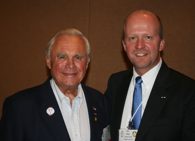
"This film showed our wives and families what real combat is like" — Capt. Joel Sugdinis, Commander, Alpha Co., 2-7 Cav
"There are certain things that you could never have
portrayed: the horrendous din of battle all around us;
the deafening noise of hundreds of weapons being fired
at close range; the shouting of orders and the screaming of
brothers warning each other of danger; the utter chaos of the
battlefield….That’s the nature of combat.’"
—Lt. Larry Gwin, executive officer, Alpha Co., 2-7 Cav
"Thank you for all the intellectual and physical effort that went into recording history for all of us. If all of America’s classrooms performed at the level found at your school, we would be blessed as a nation" — Lt. Col. Ken Weitzel (ret.) LNO on LZ Albany for 229th Helicopter Assault Bn.
"What a great way to bring history alive to the younger generation" — Lt. Bud Alley, Communications Platoon, HQ Co., 2-7 Cav




